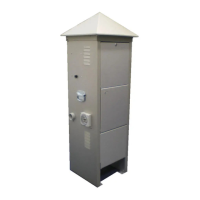HiVol 3000 User manual 1.7 Introduction
5
1.4 Background/ Theory
1.4.1 Particulate Monitoring Background
During the late 1970's the U.S. EPA began to develop health-based ambient air
quality standards for airborne particles.
The U.S. EPA concluded that particles capable of penetration through the upper
respiratory tract could deposit in the tracheobronchial and alveolar regions of the
human body and could have adverse health effects.
Researchers in the field identified that the particle size range capable of deposition
within the human thoracic region was significant for particles less than 10 µm in
diameter (PM
10
).
• In 1987 the U.S. EPA promulgated a PM
10
size-specific air quality standard
for ambient particulate matter for the protection of human health.
• In 1997 the U.S. EPA revised their national ambient air quality standards
again to include PM
2.5
. The PM
2.5
standard now replaces TSP and PM
10
as the
primary ambient air particulate pollution parameter in the United States.
Monitoring of atmospheric air quality in the United States for compliance to the
National Ambient Air Quality Standards (specified in U.S. 40 CFR Part 50) requires
the use of either reference or equivalent methods.
For PM
10
the reference method is contained in the Code of Federal Regulations -
Appendix J - Reference Method for the Determination of Particulate Matter as PM
10
in the Atmosphere.
1.4.2 Ecotech HiVol Background
High volume air samplers are used to collect samples of air-borne matter for
subsequent analysis. Generally, high volume air sampling is a technique that employs
a gravimetric method for the determination of suspended particulate matter in the
atmosphere. The term ‘gravimetric’ implies a weight measurement.
The technique of high volume air sampling developed in the United States during the
1940's. Early “HiVols” (generic term for High Volume Air Samplers) were
comprised of modified household vacuum cleaners with 100 mm diameter filters.
During the 1950's the design was altered to incorporate the use of 200 x 250 mm
filters to permit continuous 24 hour sampling.
Until the 1980's the HiVol sampler was used solely to collect data on total suspended
particulate matter (TSP). With the introduction of primary health-based particle
standards during the 1980's many HiVol samplers were retro-fitted with PM
10
Size
Selective Inlets (SSI) to capture particulate matter less than 10 µm (micro-metre or
micron) in diameter. The technique is known as High Volume Size Selective Inlet
PM
10
sampling, and monitoring is aimed at providing information on particles capable
of penetrating to the thoracic region of the human body. More recently, PM
2.5

